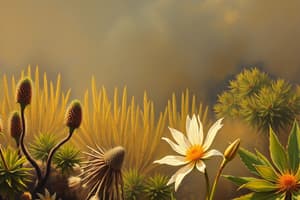Podcast
Questions and Answers
What is the main purpose of small or no leaves in desert plants?
What is the main purpose of small or no leaves in desert plants?
- To conserve water (correct)
- To absorb more water
- To produce more roots
- To grow faster
What is the function of drip tips in tropical rainforest plants?
What is the function of drip tips in tropical rainforest plants?
- To conserve water
- To grow towards sunlight
- To shed extra water (correct)
- To absorb more water
What is the main reason for deciduous trees to drop their leaves in autumn?
What is the main reason for deciduous trees to drop their leaves in autumn?
- To absorb more water
- To conserve sunlight
- To minimize water loss (correct)
- To grow new leaves
What is unique about the roots of mesquite plants?
What is unique about the roots of mesquite plants?
What is the main function of prop roots in tropical rainforest plants?
What is the main function of prop roots in tropical rainforest plants?
Why do aquatic plants have greener leaves on the upper side and red on the lower portion?
Why do aquatic plants have greener leaves on the upper side and red on the lower portion?
Flashcards are hidden until you start studying
Study Notes
What is Plant Adaptation?
- Adaptation is a process by which an organism or species becomes better suited to its environment.
- Adaptations often develop in response to a change in the organism's habitat.
Plant Adaptations in Different Environments
Desert Plants
- Desert plants like the thorny cactus and Joshua tree have:
- Small or no leaves to conserve water
- Many spines to conserve water
- Thick wax coat on leaves to retain water
- Leafless plants like cacti store water in their green stem
- Roots near the soil surface to soak up water before it evaporates
Tropical Rainforest Plants
- Plants in the tropical rainforest have:
- Drip tips and waxy coverings on leaves to shed extra water
- Prop roots to support them in shallow soil
- Grow on top of one another to reach sunlight
- Examples of plants: Bromeliads and lianas
Temperate Forest Plants
- Plants in the temperate forest have:
- Thick barks to shed them against chilly winters
- Broad leaves that capture a lot of sunlight
- Deciduous trees drop their leaves in autumn to minimize water loss
- Examples of plants: Wildflowers, oak, ash, maple, etc.
Aquatic Plants
- Aquatic plants have:
- Greener leaves on the upper side and red on the lower portion
- No stems as they do not require water to be absorbed
- Examples of plants: Water lily and lotus
Fun Facts
- The roots of the mesquite can be up to 50 to 80 meters long, the longest among desert plants.
- Grasslands are also known as prairies and have deep roots to survive prairie fires.
What is Plant Adaptation?
- Adaptation is a process by which an organism or species becomes better suited to its environment
- Adaptations often develop in response to a change in the organism's habitat
Plant Adaptations in Different Environments
Desert Plants
- Have small or no leaves to conserve water
- Have many spines to conserve water
- Have a thick wax coat on leaves to retain water
- Are leafless, storing water in their green stems (e.g., cactus)
- Have roots near the soil surface to soak up water before it evaporates (e.g., Joshua tree)
Tropical Rainforest Plants
- Have drip tips and waxy coverings on leaves to shed extra water
- Have prop roots to support them in shallow soil
- Grow on top of one another to reach sunlight (e.g., Bromeliads and lianas)
Temperate Forest Plants
- Have thick barks to protect against chilly winters
- Have broad leaves that capture a lot of sunlight
- Are deciduous, dropping leaves in autumn to minimize water loss (e.g., wildflowers, oak, ash, maple)
Aquatic Plants
- Have greener leaves on the upper side and red on the lower portion
- Do not have stems, as they do not require water to be absorbed (e.g., water lily and lotus)
Fun Facts
- Mesquite roots can be up to 50-80 meters long, the longest among desert plants
- Grasslands (also known as prairies) have deep roots to survive prairie fires
Studying That Suits You
Use AI to generate personalized quizzes and flashcards to suit your learning preferences.




